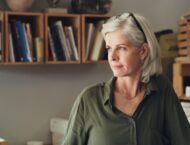Part of Kathy Caprino’s series “Girls and Women Leading The Way”
After I left my high-level corporate career in 2001 (having faced numerous serious crises and challenges that I just couldn’t understand), I became a therapist, then career coach for women. I saw how my own “perfectionistic overfunctioning” and inability to speak up powerfully or address mistreatment and gender bias contributed to my challenges. And I observed firsthand the many common and crushing challenges girls and women can face in their lives that are different from what men face. I’ve spent the past 15 years researching the many contributing factors to these challenges, and helping women overcome them. These challenges are multi-faceted, shaped by many different influences, including families, society, culture, organizations and institutions. And they are highly impacted by the systems of patriarchy that are still perpetuated, particularly in corporate America and beyond.
One groundbreaking work that explains through research and science why so many girls and women lose their confidence (between ages 8 and 13, girls lose up to one third of their confidence), is the powerful book The Confidence Code: The Science and Art of Self-Assurance – What Women Should Know which became a New York Times bestseller. I’ve referred to the research in this book countless times, in talks, coaching sessions, courses and in my new book The Most Powerful You, and have found the information truly instrumental for women’s growth.
Authors Katty Kay, Claire Shipman, and JillEllyn Riley have teamed up again for their new book Living the Confidence Code, the highly anticipated follow-up to bestselling phenomenon The Confidence Code For Girls, which spent twenty-eight weeks on the New York Times middle grade bestseller list in 2018.
They share key information that reveals how we are at a pivotal cultural moment for women’s leadership and representation—a time when all eyes will be on the first-ever female and woman of color Vice President of the United States and it’s clear that role models matter. Living the Confidence Code builds on the skills that The Confidence Code for Girls shared for teens and tweens, presenting compelling stories of more than thirty girls who have done amazing things by building their confidence. From anti-bullying advocates to climate change activists, app developers to athletes, and more, the book highlights extraordinary girls who took risks, sometimes doubted themselves, and even failed, but through it all discovered what matters most to them and found the confidence to accomplish their goals.
To learn more about how girls and young women (and also mature women) can “live” into their confidence, self-worth, authority and power, I was thrilled to catch up with the authors.
Katty Kay is a journalist, author and broadcaster and currently presents BBC World News America for the BBC. Claire Shipman is an American television journalist and currently the senior national correspondent for ABC’s Good Morning America. And JillEllyn Riley is a writer and editor with extensive experience in crafting and telling stories for both adults and children.
Here’s what they share:
Kathy Caprino: Living the Confidence Code follows your original book for girls on confidence—what’s new about this book, and what are you hoping girls will learn?
Claire Shipman: After the tremendous response to The Confidence Code for Girls, we dug into what had really resonated. And for girls, who are seeking connection, these relatable examples are especially critical. So we found 30 incredible teen girls, from around the world, with compelling confidence journeys.
Our hope is that seeing confidence in action, seeing it in real girls they could relate to, this would take the confidence lessons from our first book and help translate those into living breathing muscle memory so girls can chart their own courses and create their own paths.
And they need inspiration, like a confidence road map. Over and over we’ve noticed girls being too overwhelmed by anxiety and too frozen by perfectionism to take chances on things that will bring them joy and help them build confidence. This generation of girls is paradoxical, actually. In many ways, it’s a generation of powerful activists, less constrained by convention than previous generations. And these girls are driven to create change.
But, on the flipside, this is also a generation burdened with the twin scourges of perfectionism and anxiety, plus the pressure to please, which is now exacerbated by 24/7 social media. Building confidence actually helps them overcome all of that; it requires taking risks and embracing failing as necessary steps on the way to doing something cool, messy, and gratifying.
Caprino: What does representation mean to girls today, and why is it so important?
Katty Kay: Girls need to see themselves, other girls and women who look like them, in any place they’d ever conceive of being. As wonderful as “the first” of something is (the first woman football coach, the first “Fill in the Blank”), it’s hard to envision carving out a life somewhere as the only lonely one of your kind. Girls need to look around and see themselves reflected, and not just women, but women of color, transwomen, all kinds of different women.
Seeing women scientists allows girls to imagine themselves as scientists, for instance, expanding what they believe is possible. Teen inventor Gitanjali Rao told us, “So imagine all the other girls who are kind of just easing their way into science but being the only girl in the classroom, feeling uncomfortable.”
Or as sisters Mena and Zena Nasiri said, (their quest is to bring more books with Muslim characters to libraries and schools), “When we realized as Muslim girls, we weren’t represented, we knew it mattered.” Girls need fully fleshed-out stories, with all of the bumps and personality, in order to find more things they can grab onto—more places to connect along the narrative.
Our portraits are of decidedly “real” girls, who faced real challenges, real struggles, had real screw-ups, and therefore whose journeys are relatable and truly inspiring.
Caprino: What are the most valuable lessons you think young girls can take away from this book and put to use? And what are some of the best strategies to build their own special brand of confidence?
JillEllyn Riley: All of the girls we talked with had some useful, really specific tips or sayings or habits that really helped them on their journeys, so we signposted them along the way because even something girls might have heard before can have more impact coming from another kid.
But we also found there were clearly two larger, perhaps counterintuitive, confidence “ah-has” running through all of the girls’ stories:
When you screw up, you’re actually killing it.
When you stop thinking about yourself, your confidence can soar.
Screwing up is key. The formula for confidence involves a lot of risk and failure. To take action, all these girls had to overcome something. So if girls can somehow realize, whenever they mess up, that they’re shoveling more onto their confidence stockpile—literally, they’re making confidence—they can change negative thinking patterns more permanently.
These girls demonstrate over and over again that finding their passion in activism is not just rewarding, it’s empowering. Whether their issue is protecting animals or girls playing football; Black Lives Matter or pure, clean water; starting their own creperie, or being accepted for their true authentic identity—what matters is that it matters to them, and that they strongly connect with it. We hope girls will see all of these different issues and passions and find their own. And then we hope that they’re willing to fight for it. Willing to use their voices for it. Willing to stand up to bullies for it. That journey isn’t always pretty, as these stories show, but that’s what we want girls to see, so that they can make their own journeys.
And as we started pulling together the girls for this book, it became increasingly clear that this generation is an activist one. (Also, it was so hard to narrow it down to the 30+ girls. We could have easily doubled them. Or written 3 books!) We’d start to talk to a girl who seemed like a traditional entrepreneur, only to discover she was motivated not by profit, but by giving back to her community or making a significant positive change. It was uncanny.
Caprino: If you had to choose, which girl’s story resonates with you the most and why?
Shipman: That’s almost impossible—we feel like the parents of over 30 girls now! But if I had to chose, 12-year-old Yekeba stopping her own parent-arranged child marriage in Ethiopia is hard to beat. But we did find this to be true: the last story we’ve read is invariably our “favorite” for the day.”
Kay: I’d say the Afghan Dreamers, the all-girl robotics team from Afghanistan who invent and compete on the world stage, even in the face of physical danger. But we’ve got so many—we’ve got a story about a girl living in Guatemala, desperate for the simple right to go to school. Or two others, from different points on the globe, normalizing period empowerment so that nobody has to miss school because of this basic biological occurrence; water warriors from vast Canadian lakes to American cities to sun-soaked tropical beaches; social justice advocates fighting for all kinds of gender and racial equity; girls celebrating neuro-diversity … the list goes on and on.
Riley: I’m way too much of a softie—I can’t possibly choose. They’re all incredible—they make us cry, they make us cheer, and they leave us simultaneously smiling and pumping our fists in the air. And they were brave enough to share their stories with us. The real beauty of these is what they share: their connections and their universality. The stories show the extraordinary, yet absolutely ordinary power of this generation of girls.
Caprino: What can readers learn from this particular message to help them in the future?
Shipman: We love the way Taylor Fuentes, who’s outspoken against bullying, describes our overarching message: “Confidence is a superpower!” We know that different stories will speak to different girls, obviously, but our intention is for each reader to understand that it’s not critical what these girls have done, but how they got there.
It’s in the doing. That’s how they create something in themselves that matters, confidence, that will actually last a lifetime.
For more information visit ConfidenceCodeGirls.com or join the community on Instagram and Facebook.
Kathy Caprino is a career and leadership coach, speaker, educator, and author of The Most Powerful You: 7 Bravery-Boosting Paths to Career Bliss. She helps professional women build their most rewarding careers through her Career Breakthrough programs and Finding Brave podcast.





